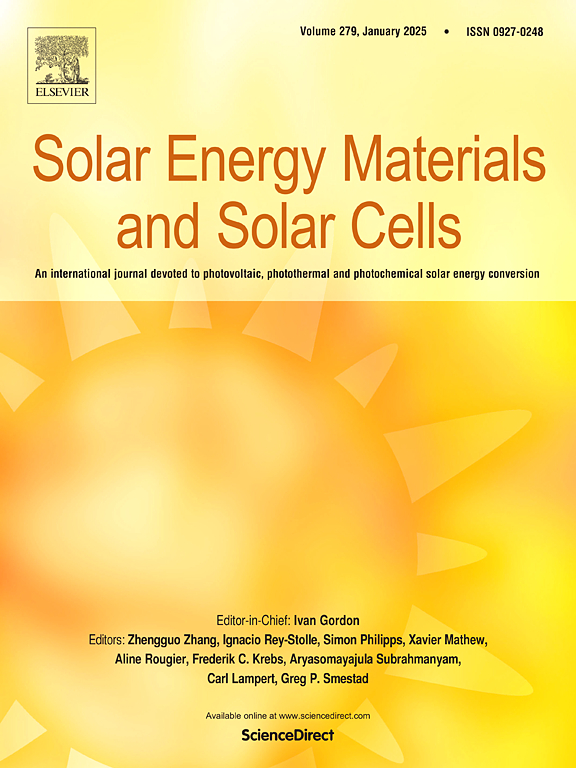通过后侧选择性凹陷金字塔结构和斑马交叉钝化接触,使高效TOPCon太阳能电池具有95%的双面性
IF 6.3
2区 材料科学
Q2 ENERGY & FUELS
引用次数: 0
摘要
太阳能电池的双面性在决定其整体发电性能方面起着至关重要的作用,特别是在高反射率环境中,增强后侧光吸收可以显着提高功率输出。与硅异质结太阳能电池相比,隧道氧化物钝化接触(TOPCon)太阳能电池进一步提高市场竞争力的主要障碍是其较低的双面性。在这项工作中,我们报道了通过在非电极区域形成后侧选择性凹陷金字塔结构,TOPCon太阳能电池具有94.3%的优异双面性。在不牺牲效率的前提下,开发了斑马交叉钝化接触技术,在银电极下设计了SiO2/poly-Si/Al2O3/SiNx钝化层,在背面织构区设计了Al2O3/SiNx钝化层。与基线相比,优化后的后侧短路电流密度增加了3.26 mA/cm2,导致后侧光吸收和电流产生显着改善。作为概念验证,双面TOPCon光伏组件封装具有令人印象深刻的91.7%的双面性和722.0 W的功率输出。这是迄今为止对TOPCon太阳能电池和组件的最高双面性的最好认识。我们的研究为设计高双面TOPCon太阳能电池和组件提供了蓝图,使其比传统的玻璃/背板组件更高效、更通用,并加速了实际应用。本文章由计算机程序翻译,如有差异,请以英文原文为准。
Enabling 95 % bifaciality of efficient TOPCon solar cells by rear-side selective sunken pyramid structure and zebra-crossing passivation contact
The bifaciality of solar cells plays a crucial role in determining their overall energy generation performance, particularly in high-reflectance environments where enhanced rear-side light absorption can significantly boost power output. Compared to silicon heterojunction solar cells, a major barrier to the further increasing market competitiveness of tunnel oxide passivated contact (TOPCon) solar cells is the lower bifaciality. In this work, we reported an excellent 94.3 % bifaciality of TOPCon solar cells by formation of rear-side selective sunken pyramid structure on the non-electrode area. The zebra-crossing passivation contact technology was developed without sacrificing the efficiency, where the passivation layers were designed as SiO2/poly-Si/Al2O3/SiNx under silver electrodes and Al2O3/SiNx on rear-side texture area. The optimised rear-side short-circuit current density increased by 3.26 mA/cm2 compared to the baseline, leading to a notable improvement in rear-side light absorption and current generation. As a proof-of-concept, the bifacial TOPCon photovoltaic modules were encapsulated with an impressive bifaciality of 91.7 % and a power output of 722.0 W. It is the highest bifaciality so far for TOPCon solar cells and modules to the best knowledge. Our study offers a blueprint for designing high bifaciality TOPCon solar cells and modules, making them more efficient and versatile than traditional glass/backsheet modules and accelerating practical application.
求助全文
通过发布文献求助,成功后即可免费获取论文全文。
去求助
来源期刊

Solar Energy Materials and Solar Cells
工程技术-材料科学:综合
CiteScore
12.60
自引率
11.60%
发文量
513
审稿时长
47 days
期刊介绍:
Solar Energy Materials & Solar Cells is intended as a vehicle for the dissemination of research results on materials science and technology related to photovoltaic, photothermal and photoelectrochemical solar energy conversion. Materials science is taken in the broadest possible sense and encompasses physics, chemistry, optics, materials fabrication and analysis for all types of materials.
 求助内容:
求助内容: 应助结果提醒方式:
应助结果提醒方式:


